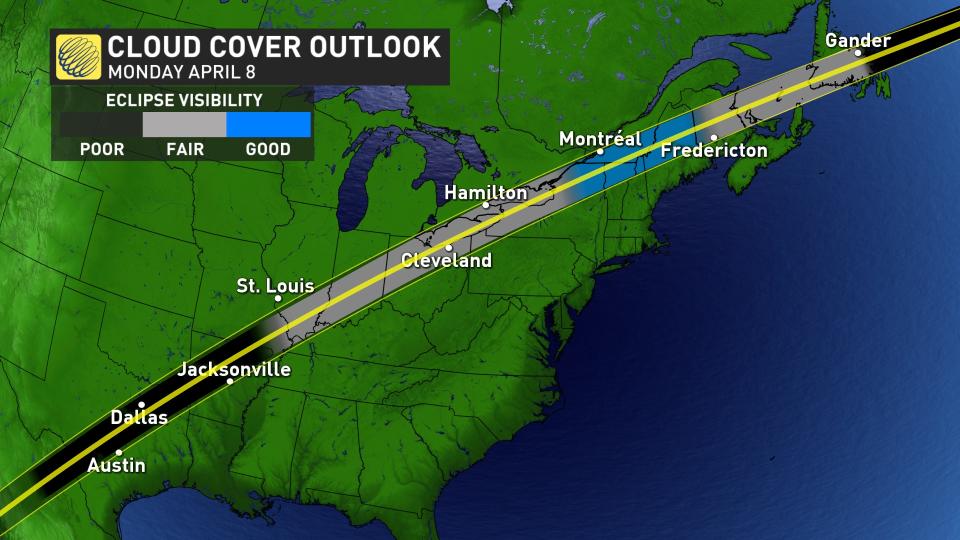Canada might score the best seat for Monday's eclipse after all

With just under one week to go before the much-anticipated celestial event that is expected to draw more than one million visitors to Niagara Falls, prompting the city to issue a state of emergency, forecasters are getting a clearer picture of what to expect.
And things are looking great for Canada. In fact, parts of the country may have the best seats in the house to view the solar eclipse, whether it's a partial glimpse or a full viewing in the path of totality –– depending on the location.

RELATED: Niagara Falls declares state of emergency ahead of influx of eclipse visitors
As we look at the weather models, what we see as of Monday, April 1 is a ridge of high pressure pattern coming to fruition over parts of Eastern Canada –– Ontario, Quebec and New Brunswick.
What that means is a realistic chance for millions to view the eclipse as the pattern is renowned for its sinking air and clearer skies. So, don't prepare the car for a long haul just yet. You may not need to travel far for a premium, front-row seat to the spectacle.
In fact, as it may turn out, the best seat in the house might just be in your backyard.
DON'T MISS: Everything you need to know for April's spectacular and rare solar eclipse
First cloud-cover forecast favours some Canadian locales over others
After mulling over the available data, we have formulated our first cloud-cover forecast for the event. As always, more intricate details will become fine-tuned closer to April 8, so expect some shifts and changes in the days leading up to it.

Our highest confidence forecast exists in southern Quebec, parts of eastern Ontario and portions of New Brunswick for a good viewing opportunity.
These regions are looking to be sandwiched in between two systems, so sunshine and partly cloudy conditions are the most likely outcome. The timing of a weekend system’s departure will make all the difference in Atlantic Canada, resulting in our medium confidence for fair conditions. Newfoundland has a chance of lingering showers and poor visibility on the day of the eclipse, if the system’s movement is sluggish.
Our lowest confidence exists in southern Ontario for fair conditions.

SEE ALSO: Totality, corona, Baily's beads - Do you know your solar eclipse terminology?
We are not expecting a washout here by any means, but forecasters are concerned with high cirrus clouds spilling in by the afternoon. Will we be looking at the eclipse through a veil of clouds? It’s definitely possible.
Ironically, climatology was not a factor at all. In fact, it got it all wrong. Historical cloud cover data during early April favours the south-southwestern end of North America with the greatest percentage of clear skies, with Mexico and Texas normally seeing 20 to 40 per cent cloud cover.
For Monday, though, it appears the least visibility odds are in the southwestern U.S., thanks to a deep trough and developing low that will be spread over much of the states.
WATCH: The role clouds will play during the eclipse
Check back with The Weather Network as we continue to update the eclipse forecast leading to and on April 8.
A total solar eclipse will plunge parts of North America into temporary daytime darkness on April 8, 2024, as the Moon passes in front of the Sun. Here's everything you need to know about who will see the eclipse and when, and how to view it safely: https://t.co/s5Yl8c6vSW pic.twitter.com/42B0FicQwD
A total solar eclipse will plunge parts of North America into temporary daytime darkness on April 8, 2024, as the Moon passes in front of the Sun. Here's everything you need to know about who will see the eclipse and when, and how to view it safely: The Weather Network on Twitter: "A total solar eclipse will plunge parts of North America into temporary daytime darkness on April 8, 2024, as the Moon passes in front of the Sun. Here's everything you need to know about who will see the eclipse and when, and how to view it safely: https://t.co/s5Yl8c6vSW pic.twitter.com/42B0FicQwD / Twitter" The Weather Network on Twitter: "A total solar eclipse will plunge parts of North America into temporary daytime darkness on April 8, 2024, as the Moon passes in front of the Sun. Here's everything you need to know about who will see the eclipse and when, and how to view it safely: https://t.co/s5Yl8c6vSW pic.twitter.com/42B0FicQwD / Twitter"
— The Weather Network (@weathernetwork) The Weather Network on Twitter: "A total solar eclipse will plunge parts of North America into temporary daytime darkness on April 8, 2024, as the Moon passes in front of the Sun. Here's everything you need to know about who will see the eclipse and when, and how to view it safely: https://t.co/s5Yl8c6vSW pic.twitter.com/42B0FicQwD / Twitter"
(Thumbnail courtesy of Pexels)


